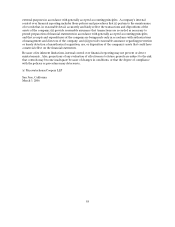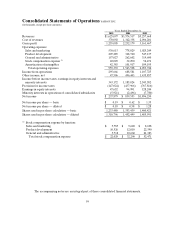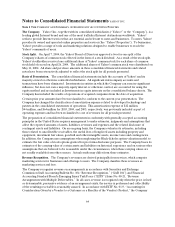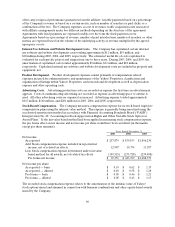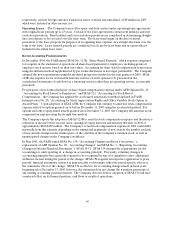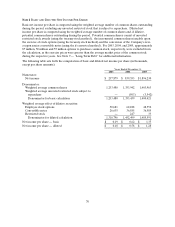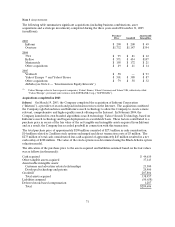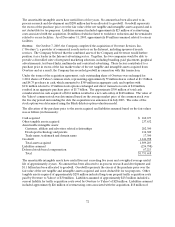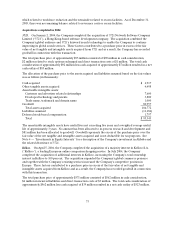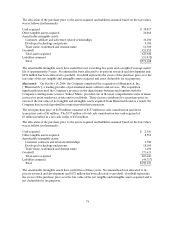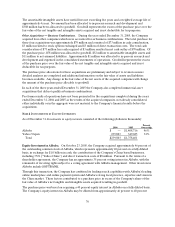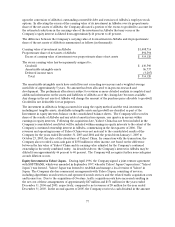Yahoo 2005 Annual Report Download - page 74
Download and view the complete annual report
Please find page 74 of the 2005 Yahoo annual report below. You can navigate through the pages in the report by either clicking on the pages listed below, or by using the keyword search tool below to find specific information within the annual report.68
The carrying amounts of these investments are greater than the underlying equity in net assets of these
companies due in part to goodwill, which is not subject to amortization in accordance with SFAS No. 142
(“SFAS 142”) “Goodwill and Other Intangible Assets.” This goodwill is evaluated for impairment in
accordance with Accounting Principles Board (“APB”) Opinion No. 18, “The Equity Method of Accounting
for Investments in Common Stock.”
Concentration of Risk. Financial instruments that potentially subject the Company to significant
concentration of credit risk consist primarily of cash, cash equivalents, marketable debt securities and
accounts receivable. As of December 31, 2005, substantially all of the Company’s cash, cash equivalents
and investments were managed by six financial institutions. Accounts receivable are typically unsecured
and are derived from revenue earned from customers. The Company performs ongoing credit evaluations
of its customers and maintains allowances for potential credit losses. Historically, such losses have been
within management’s expectations. As of December 31, 2004 and 2005, no one customer accounted for
10 percent or more of the accounts receivable balance and no one customer accounted for 10 percent or
more of the Company’s revenues for 2003, 2004, or 2005.
Long-Lived Assets.
Property and Equipment. Buildings are stated at cost and depreciated using the straight-line method over
the estimated useful lives of 25 years. Leasehold improvements are amortized over the lesser of their
expected useful life and the remaining lease term. Computers and equipment and furniture and fixtures
are stated at cost and depreciated using the straight-line method over the estimated useful lives of the
assets, generally two to five years. The Company recognized depreciation expense on property and
equipment of approximately $105 million, $165 million and $224 million for 2003, 2004, and 2005,
respectively.
Goodwill. Goodwill is carried at cost. Goodwill is not amortized but is subject to an annual test for
impairment at the reporting unit level (operating segment or one level below an operating segment) and
between annual tests in certain circumstances. The performance of the test involves a two-step process.
The first step of the impairment test involves comparing the fair value of the Company’s reporting units
with the reporting unit’s carrying amount, including goodwill. The Company generally determines the fair
value of its reporting units using the expected present value of future cash flows, giving consideration to
the market valuation approach. If the carrying amount of a reporting unit exceeds the reporting unit’s fair
value, the Company performs the second step of the goodwill impairment test to determine the amount of
impairment loss. The second step of the goodwill impairment test involves comparing the implied fair
value of the reporting unit’s goodwill with the carrying amount of that goodwill.
Intangible Assets Other than Goodwill. Intangible assets other than goodwill are carried at cost less
accumulated amortization. Intangible assets are generally amortized on a straight-line basis over the
useful lives of the respective assets, generally two to seven years. Long-lived assets and certain identifiable
intangible assets to be held and used are reviewed for impairment whenever events or changes in
circumstances indicate that the carrying amount of such assets may not be recoverable. Determination of
recoverability is based on an estimate of undiscounted future cash flows resulting from the use of the asset
and its eventual disposition. Measurement of any impairment loss for long-lived assets and certain
identifiable intangible assets that management expects to hold and use is based on the amount the carrying
value exceeds the fair value of the asset.
Foreign Currency. The functional currency of the Company’s international subsidiaries is generally the
local currency. The financial statements of these subsidiaries are translated into United States dollars
using period-end rates of exchange for assets and liabilities and average rates of exchange for the period
for revenues and expenses. Translation gains (losses) are recorded in accumulated other comprehensive
income (loss) as a component of stockholders’ equity. The Company recorded net foreign currency
transaction gains, realized and unrealized, of approximately $3 million and $6 million in 2003 and 2004,


